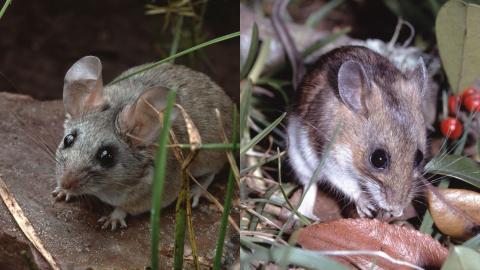Key Findings

To live in hotter more desert-like surroundings, and exist without water, adapted animals have developed genetic mechanisms enabling them to better survive. Different genes and functions often allow for the same adaptation.
About the Co-Author

Matthew MacManes, Associate Professor of Genomes Enabled Biology
Contact information: Matthew.Macmanes@unh.edu
603-862-4052, MacManes Lab website
This research first published in Journal of Heredity.
Researchers: J. Colella, A. Tigano, O. Dudchenko, A. Omer, R. Khan, I. Bochkov, E. Aiden and M. MacManes
Researchers from UNH and from Baylor University found that to live in hotter more desert-like surroundings, and exist without water, there is more than one genetic mechanism allowing animals to adapt. This information could provide important biomedical groundwork to develop gene therapies to treat human dehydration related illnesses, like kidney disease. The scientists published their findings in an article in the Journal of Heredity, where they compared the genetic mechanisms of three species of mice found in warm and dry areas; the cactus and canyon mice, both found predominately in desert habitats, and the North American deer mouse, which can also be found in colder, wetter climates in the northern United States.
The researchers hypothesized that similar genes in each species would be critical to survive in desert environments. What they found was that each species used a different mechanism, meaning different genes and functions allowing for the same adaptation. One species adapted through mutational genetic changes over time and another used changes in gene expression which can occur more quickly and may be the more efficient evolutionary route.
“Because mice are physiologically similar to humans, this type of evolutionary work offers important first steps toward identifying and understanding genes that control complex traits like dehydration.”
“Because mice are physiologically similar to humans, this type of evolutionary work offers important first steps toward identifying and understanding genes that control complex traits like dehydration, which can compromise human kidneys causing lifelong, irreparable damage,” said co-author Matt MacManes, associate professor of genome enabled biology at UNH.

Each year millions of people die of dehydration related illness around the world. Experts say even minor dehydration can compromise the kidneys causing lifelong issues.
This work was funded by the National Institute of Health National Institute of General Medical Sciences to M.D.M. (1R35GM128843). Co-authors include J. Colella, A. Tigano, O. Dudchenko, A. Omer, R. Khan, I. Bochkov, E. Aiden and M. MacManes.